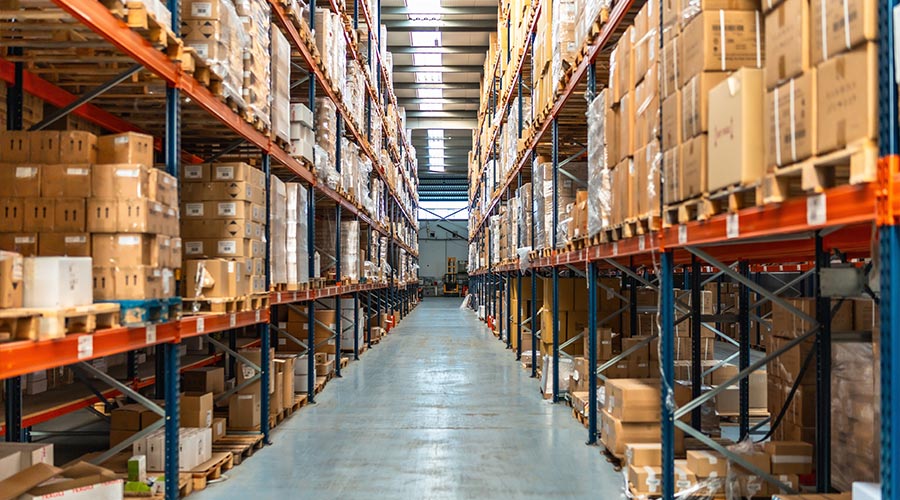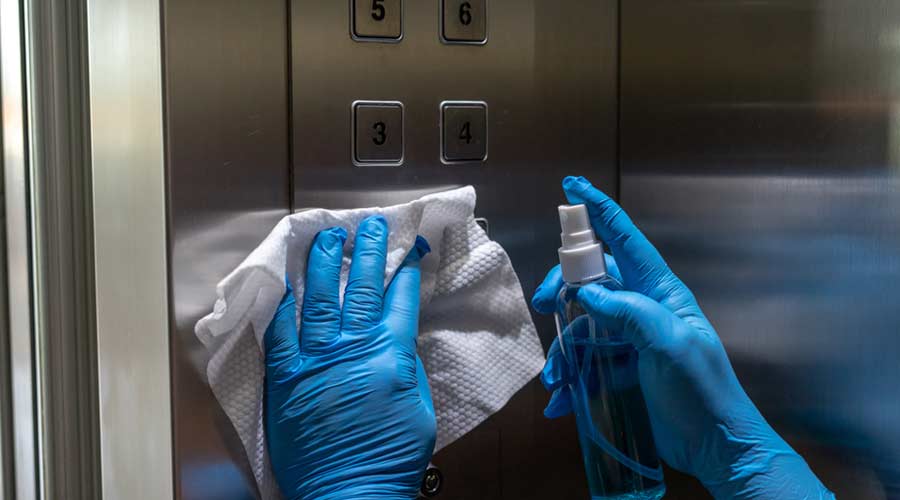
From stacked pallets and high-traffic aisles to racks of flammable chemicals and corrosives, jan/san distribution warehouses are busy environments where safety must be built into every process. Yet too often, day-to-day pressures such as tight delivery windows, rapid product turnover, and limited floor space, can lead to shortcuts that compromise safety and compliance. The result can be injuries, fines, product damage, or worse, loss of life.
The U.S. Environmental Protection Agency (EPA) recently issued a safety advisory that noted many distribution facilities do not store hazardous chemicals properly, underscoring just how easily warehouse operations can become high-risk zones. But chemicals aren’t the only concern in the jan/san warehouse. Inspections by the Occupational Safety and Health Administration (OSHA) and EPA have found repeated violations related to poor labeling, blocked exits, inadequate ventilation, damaged racking systems, and improper material handling practices, all of which threaten worker safety and a company’s bottom line.
Jan/san warehouse safety demands proactive management, continuous training, and routine inspections. But the first step to better warehouse safety is to determine where distribution facilities are going wrong.
Top 10 Warehouse Violations
At the National Safety Council’s (NSC) 2025 Safety Congress & Expo in September, OSHA announced its most frequently cited workplace safety standards for the 2025 fiscal year. The top 10 list included:
1. Fall Protection
2. Hazard Communication
3. Ladders
4. Lockout/Tagout
5. Respiratory Protection
6. Fall Protection Training Requirements
7. Scaffolding
8. Powered Industrial Trucks
9. Personal Protective and Lifesaving Equipment (PPE)-Eye and Face Protection
10. Machine Guarding
Lorraine Martin, CEO of NSC, states that while progress has been made in many workplaces, the consistency of citation rankings over time implies that more work remains.
“The safety community must intensify its efforts to better protect workers and save lives,” she says. “We can do this through robust training, updated metrics, high-hazard identification, and control implementation, coupled with employee engagement and leadership accountability.”
With this in mind, jan/san distributors can support safety and regulatory compliance by standardizing processes, equipment, and training, according to Jeri Connolly, Vice President of Environmental, Health, and Safety (EHS) for Imperial Dade, Jersey City, New Jersey.
“If you focus on the top 10 regulations, like forklifts, lockout/tagout, PPE, and confined spaces, you’re already taking a major step forward,” she says.
To make that step forward, experts suggest jan/san distributors take seven specific actions.
7 Big Steps
Step 1: Promote Proper PPE Use
Proper and consistent PPE use continues to be a challenge in warehouse environments. One issue is that there is often little diversity in the PPE that's kept on hand.
“You cannot have one-size-fits-all gloves and harnesses; they aren’t standardized for everyone,” Connolly says. “Get feedback from your staff. When workers have a say in what fits and works best for them, they’re far more likely to comply.”
Connolly points out that discomfort and a false sense of security can lead to complacency.
“Sometimes, unfortunately, it’s that thought process of, ‘Well, it’s never happened to me,’ and workers are willing to take that risk,” she says. “But every policy and process we have has been written in blood. Someone was injured or killed before these rules existed. That’s why it’s critical for businesses to know their data, understand where incidents are happening, and act to mitigate those risks.”
Step 2: Keep It Clean
Housekeeping and organization are among the first things safety consultants check. Stephen Tamburello, Protection Engineer (PE), and Project Manager for Telgian Engineering and Consulting, Phoenix, says good housekeeping includes ensuring products and pallets do not block corridors, aisles, and egress to exits. It also includes clear organization, with signage, directional arrows, stop signs, designated trash and fire extinguisher locations, and restricted pallet zones.
Communication of operational processes to employees also improves safety, according to Connolly.
“Clear communication with employees about where everything goes prevents accidents before they happen,” she says. “When employees help and coach each other, with supervisors actively engaged on the floor, that’s a powerful indicator of a safety-minded culture.”
Step 3: Cultivate Chemical Know How
Workers, communities, and operations face risks when jan/san warehouses fail to manage hazardous materials properly. Anything from mislabeled drums and incompatible chemical storage to missed inspections and incomplete reporting can trigger an OSHA audit, or even catastrophic events such as fires, toxic releases, or explosions. Tamburello suggests marking storage areas on a floor with paint so that staff know where to properly store materials and how high they can be placed.
Proper chemical storage demands that workers fully understand where the safety data sheet (SDS) is located and the hazards these products present. For instance, certain chemicals cannot be stored next to each other. Some are highly flammable; others less so. It’s vital that employees know the exposure limits, as well as the proper cleanup methods for different types of spills.
What’s more, chemical safety doesn’t stop at the warehouse door.
“Jan/san operations also transport chemicals,” Connolly says. “How products are wrapped on pallets, what can be placed next to them, and how they’re loaded onto trucks is highly regulated. Safe warehousing extends into safe delivery.”
Step 4: Focus on Moving Violations
The most frequent and costly warehouse safety incidents involve forklift and racking collisions.
“The No. 1 thing I see is forklift versus racking,” Connolly says. “Even minor collisions can cascade into bigger problems, especially in jan/san operations where chemicals or other materials are involved. You might have two or three people affected, a supervisor pulled into an investigation, equipment repairs, racking replacement, and delays in fulfilling orders. It all adds up.”
Consider the interaction of equipment, employees, and products. Where are chemicals stored? Where are high-traffic areas? Where are break rooms located?
“Laying this out proactively prevents employees from walking through battery charging areas or other hazards,” Connolly says.
Technology and clear operational design can also help reduce accidents.
“Top speeds for forklifts should be limited, directional arrows should guide traffic, and pedestrian paths need to be clearly defined,” Connolly adds. “Combine that with pre-trip checks, PPE enforcement, and camera systems to monitor ergonomics and hazards, and you dramatically reduce risks.”
Step 5: Embrace Wearable Tech
As jan/san distributors look for new ways to protect workers and improve operational efficiency, wearable technologies are emerging as a practical tool. Smart devices can be used in warehouse environments to monitor safety, reduce injury risk, and support productivity.
Wearables come in a variety of forms. Smart helmets can enhance head protection, monitor fatigue, identify nearby hazards, and even overlay augmented reality guidance. Vests and other smart clothing can track vital signs to prevent heat stress or overexertion during peak operational periods. Ergonomic sensors can monitor body position and lifting techniques to reduce musculoskeletal injuries.
Some devices also include GPS functionality and can alert employees when they enter high-traffic areas near forklifts or areas where materials are being moved. For example, a worker retrieving supplies near a busy loading dock might receive a real-time alert to exercise caution around moving equipment.
“Wearable technologies are a great way to add an extra layer of protection and awareness,” Connolly says. “They help mitigate risks that are difficult to engineer out, especially in fast-moving warehouse environments where employees are handling chemicals, heavy equipment, and high-volume inventory.”
Step 6: Promote Policy and Processes
Written policies and processes are the backbone of a safe and efficient operation. Yet, safety policies are only useful if they are regularly reviewed and revised.
“Policies must be reviewed at least annually,” Connolly says. “Every time you have an incident or a near miss, you need to review your processes to see if they’re still working, then make adjustments as needed.”
Safety experts must keep up with the best practices and industry standards to maintain a current policy framework. Involving external specialists such as consultants, partners, or vendors can help pinpoint risks, rank their importance, and determine the best course of action for the company.
Step 7: Tackle Training
There is no replacement for hands-on supervision and coaching. Real-time observation, coaching, and education are best when supervisors are on the floor.
“Toolbox talks, monthly training, and huddles are great, but if supervisors aren’t out there using the data and watching what’s happening, they lose touch with the reality of warehouse operations,” says Connolly. “That human element is essential to truly effective and safe warehouses.”
Experts also recommend connecting policies to the day-to-day realities of employees. Safety policies are most effective when employees understand the “why” behind them.
Just implementing one of these seven steps will have benefits, but it’s imperative that jan/san distributors examine and exercise them all. Safety concerns continue to be an issue in the warehouse, and one accident is one too many. Distributors would be wise to do anything they can to mitigate risk.
Ronnie Wendt is a freelance writer and owner of In Good Company Communications in Waukesha, Wisconsin.

 The Down and Dirty on Cleaning in Virus Season
The Down and Dirty on Cleaning in Virus Season How Surfactant Use is Expanding in Commercial Cleaning
How Surfactant Use is Expanding in Commercial Cleaning